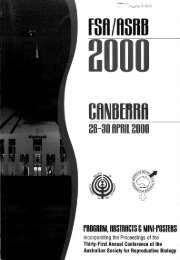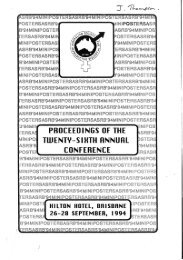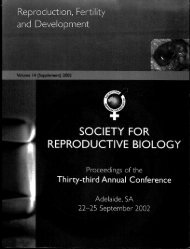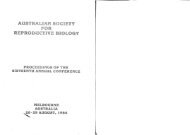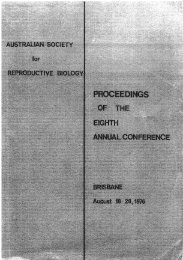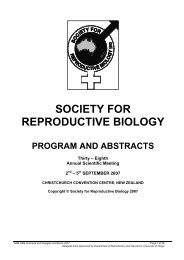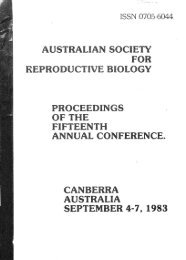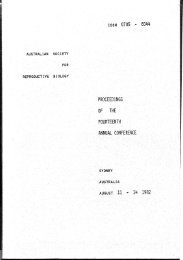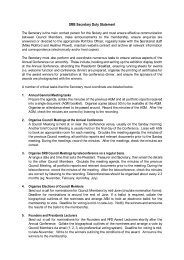N OCIETY' - the Society for Reproductive Biology
N OCIETY' - the Society for Reproductive Biology
N OCIETY' - the Society for Reproductive Biology
You also want an ePaper? Increase the reach of your titles
YUMPU automatically turns print PDFs into web optimized ePapers that Google loves.
THE EFFECTS OF WHOLE BODY HEAT-STRESS OF MALE MICEONASPECTSOFPATERNALFERTaITY· The Role of Mitochondriain Ischaemic/ Re-Perfusion Injury in Rat Testes·F. A. Ahmed l , J. Whelan l , A.M. Jequier2, and 1. M. Cummins 3lDepartment ofBioc~emistr;, ~~~ersity of ':'estemAus~alia,~edla~ds 6907 WA, 2perthAndrology, WesternAustralIa and DIVISIOn ofVetennary and BIOmedIcal SCIence, Murdoch UniversityIntroductionThe aim ofthis study was to gain fur<strong>the</strong>r insight into<strong>the</strong> mechanism underlying ischemic/re-perfusiondamage in <strong>the</strong> testis. It has been proposed that <strong>the</strong>mitochondria is <strong>the</strong> target <strong>for</strong> reactive oxygen speciesmediated damage (1). A rat model <strong>for</strong> male infertilitywas developed, using torsion followed by variousperiods of recovery. The mitochondrial "commondeletion" was measured in <strong>the</strong>se testes as an indicatorofgeneral mitochondrial damage. We also hypo<strong>the</strong>sizedthat this type ofdamage leads to <strong>the</strong> induction ofcertainfactors that playa vital role in apoptosis and protectionof <strong>the</strong> suviving cells, hence we carried out an RNAsubtractive hybridization between <strong>the</strong> control and <strong>the</strong>torsioned testes to identify differentially expressedgenes.Materials & MethodsThe study was comprised ofeight groups of3 rats each.Groups 1-3 were controls, groups 4-8 subjected tounilateral testicular torsion and allowed to recover <strong>for</strong>ei<strong>the</strong>r 0, 1 hour, I day, 1 wk or 4 weeks respectively.The mitochondrial common deletion was estimatedusing a competitive quantitative PCR assay that wasspecifically developed <strong>for</strong> this study (2). The effect oftorsion on <strong>the</strong> testes was detennined by <strong>the</strong> testicularbiopsy score count on representative tissues.Differentially expressed genes were isolated usingClontech PCR-select cDNA subtraction kit.ResultsBased on <strong>the</strong> biopsy scores it was clear that <strong>the</strong>experimental model produced testicular damage thatwas more severe in <strong>the</strong> longer recovery groups (Tablel).However this did not correlated to <strong>the</strong> extent of <strong>the</strong>"common deletion " since no significant differenceswere seen between <strong>the</strong> control and torsioned testes (Fig1).Table 1. Testicular biopsy score counts in rat testestaking by counting 30 tubules in three rat testes. C is<strong>the</strong> control testes and T is <strong>the</strong> torsioned testes. Scoresbelow 10 are considered subfertile. The values of <strong>the</strong>short and long recovery groups were averaged.Groupcontrolnon-recovery-Cnon-recovery-Tshort recovery-Cshort recovery-Tlong recovery··Clong recovery-T60Average Score9.9 ± 0.189.9 ± 0.189.8 ± 0.379.8 ± 0.378.3 ± 1.99.7 ± 0.52.4 ± 1.2918 clones were found to be differentially expressed bytorsioned testes. Nor<strong>the</strong>rn blots and sequecing are nowbeing undertaken to confirm which ones are truelydifferentially expressed and detennine <strong>the</strong>ir identity.0.05



